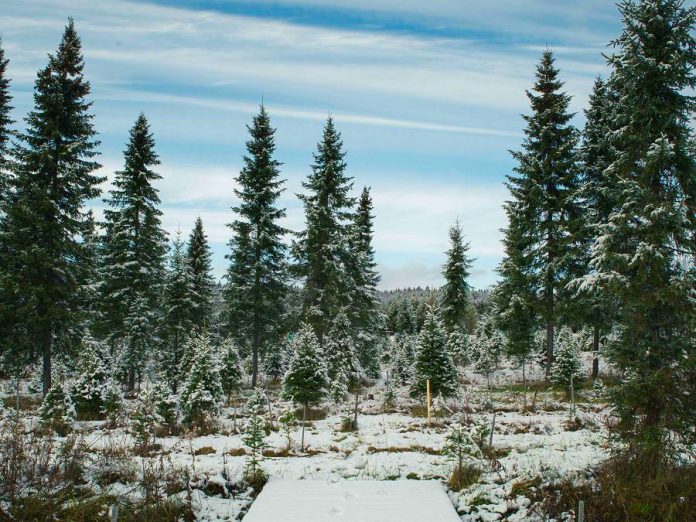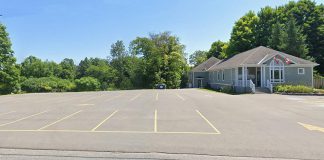
If harvesting your own fresh local Christmas tree is a holiday tradition for your family, there are a couple of important things you need to know this year.
First, because of the pandemic, all Christmas tree farms have COVID-19 health and safety protocols in place.
Second, unless you want to end up with a Charlie Brown tree, don’t delay in getting your tree this year. With more families staying at home during the holidays during the pandemic, there’s a high demand for trees — and that means shortages are expected.
There are six tree farms in the Kawarthas where you can harvest your own tree: Potash Creek Farms in Omemee, Barrett’s Tree Farm in Cobourg, J & D Trees in Colborne, Murray Tree Farm in Apsley, Dawson Tree Farm in Millbrook, and Oake Family Tree Farm in Cavan-Monaghan. Kol Tree Farms in Roseneath is permanently closed and Little Lake Christmas Trees in Cramahe doesn’t appear to be open this year.
If you’re willing to drive just outside the Kawarthas, you can also harvest your own tree at Powell’s Trees in Bowmanville and Blackstock Christmas Tree Farm in Blackstock.
Due to the pandemic, there are new COVID-19 health and safety protocols at all tree farms. A limited number of people will be allowed at one time. You’ll need to wear your face mask when paying for your tree. There will be no hot drinks or snacks available, and no hay rides. Customers are encouraged to bring their own hand saw; some farms have limited saws available (usually with a deposit) that will be sanitized after customer use. Check the tree farm’s website for their specific COVID-19 protocols.
Here’s where you can harvest your own Christmas tree in the greater Kawarthas region:
- Barrett’s Tree Farm (3141 Williamson Rd. N., Cobourg, 905-342-2622)
- Blackstock Christmas Tree Farm (4060 Mountjoy Rd., Blackstock, 905-439-9253)
- Dawson Tree Farm (243 Zion Line, Millbrook, 905-261-7415 or 905-243-5136)
- J & D Trees (13809 Telephone Rd., Colborne, 905-355-3009)
- Murray Tree Farm (8786 Highway 28, Apsley, 416-438-0879)
- Oake Family Tree Farm (2474 Sherbrooke St. W., Cavan-Monaghan, 705-740-3393)
- Potash Creek Farms (400 Grassy Rd., Omemee, 705-879-4489)
- Powell’s Trees (2945 Regional Rd. 20, Bowmanville, 905-263-2762)
For available tree species, hours, prices, and websites (including the farms’ COVID-19 protocols), check out our map:
View a larger version of this map.
Why buy a grown-in-Ontario Christmas tree?
Besides helping the local economy (more than 600 Christmas tree farms in Ontario generate around $12 million), farm-grown natural Christmas tree have other benefits.
Christmas trees are one of the most environmentally friendly crops. It takes up to 10 years to grow each tree and, during this time, the trees remove carbon dioxide and airborn pollutants from the atmosphere (up to 13 tons per acre!) and provide protective havens for a wide variety of birds and mammals. It’s also a sustainable crop — for every tree that’s harvested, at least three seedlings are planted in its place.
Natural Christmas trees are also 100% recyclable and biodegradable. Most municipalities — including those in the Kawarthas — collect discarded natural Christmas trees and chip them for use as mulching materials. Discarded natural trees can also be used as bird feeders, wood products can be made from their stems, or they can be used as wildlife cover in fish ponds and woodlots.
Common types of Christmas trees
If you do decide to harvest your own tree this year (or buy a pre-cut one), here’s a quick primer on the most common tree species available:
Scots Pine (Scotch Pine) – The most popular Christmas tree in Canada, the Scots Pine is a thick and hardy tree. It resists drying and holds its needles well over the holidays. However, the needles are tough and very pointy.
Balsam Fir – Almost as popular as the Scots Pine, the Balsam Fir holds its dark-green needles well and is a good choice if the decorated tree will be left standing for a longer period of time. Balsam fir branches work well for lighter Christmas ornaments, and the tree has a strong fragrance.
Fraser Fir – A Christmas tree that’s become very popular in recent years, the Fraser Fir is known for holding its attractive dark blue-green needles and its pleasant scent. Fraser Firs are generally more expensive than other trees as the species has a much longer growing cycle.
Norway Spruce – The traditional Christmas tree in Britain, the Norway spruce is attractive but has a tendency to drop its needles, particularly towards the end of the holidays — especially if the tree is not cut fresh and kept properly watered.
White Spruce – The dense foliage and symmetrical proportions of the White Spruce make it a very beautiful Christmas tree. The tree has a strong scent and its strong slender twigs hold ornaments well. However, the White Spruce is very thirsty and must be watered regularly to prevent it from losing its needles.
Caring for your tree
After you get your tree, here are some tips to keep it fresh and safe:
- If you aren’t setting up the tree immediately, store it outdoors. Keep it in a protected area, away from the wind and sun, to help the tree retain its moisture (an unheated garage is ideal, particularly to keep the tree free of snow). If you plan to store it outside for several days, make a straight cut across the butt end of the tree about one inch from the end, place the butt end in a container of water, and store the tree upright.
- When you bring the tree into the house for decorating, make another fresh cut across the trunk, about an inch from the original cut.
- Trees can drink up to four litres of water per day, so be sure to use a large stand that can hold that much water. Check the water level daily and supply fresh water as needed. Don’t allow the water level to drop below the bottom of the tree, as a seal will form on the bottom and the tree will stop absorbing water (you’ll have to make a new cut).
- Use only fresh water. Don’t add sugar, molasses, bleach, honey, floral preservatives, or other substances to the tree’s water. Experts agree that these do nothing to maintain the freshness of the tree.
- Place your tree away from fireplaces, radiators, television sets, and other sources of heat. Turn off the tree lights when you leave and before you retire at night. Under no circumstances should you use lighted candles on a Christmas tree.
- A well-maintained tree should normally remain fresh at least three to four weeks before drying to an unacceptable level. Test the dryness of the tree by running your fingers across the needles. If they break easily or fall off in your hand, the tree is dry and should be discarded.


























